Mybatis源码详解系列(二)--Mybatis如何加载配置及初始化
简介
Mybatis 是一个持久层框架,它对 JDBC 进行了高级封装,使我们的代码中不会出现任何的 JDBC 代码,另外,它还通过 xml 或注解的方式将 sql 从 DAO/Repository 层中解耦出来,除了这些基本功能外,它还提供了动态 sql、延迟加载、缓存等功能。 相比 Hibernate,Mybatis 更面向数据库,可以灵活地对 sql 语句进行优化。
前面已经说完 mybatis 的使用( Mybatis详解系列(一)--持久层框架解决了什么及如何使用Mybatis ),现在开始分析源码,和使用例子一样,我用的 mybatis 是 3.5.4 版本的。考虑连贯性,我会按下面的顺序来展开分析,计划两篇博客写完,本文只涉及第一点内容:
- 加载配置、初始化
SqlSessionFactory; - 获取
SqlSession和Mapper; - 执行
Mapper方法。
这个过程基本符合下面的代码的工作过程。
// 加载配置,初始化SqlSessionFactory对象
String resource = "Mybatis-config.xml";
InputStream in = Resources.getResourceAsStream(resource));
SqlSessionFactory sqlSessionFactory = new SqlSessionFactoryBuilder().build(in);
// 获取 SqlSession 和 Mapper
SqlSession sqlSession = sqlSessionFactory.openSession();
EmployeeMapper baseMapper = sqlSession.getMapper(EmployeeMapper.class);
// 执行Mapper方法
Employee employee = baseMapper.selectByPrimaryKey(id);
// do something
注意,考虑可读性,文中部分源码经过删减。
初始化的过程
这里简单概括下初始化的整个流程,如下图。
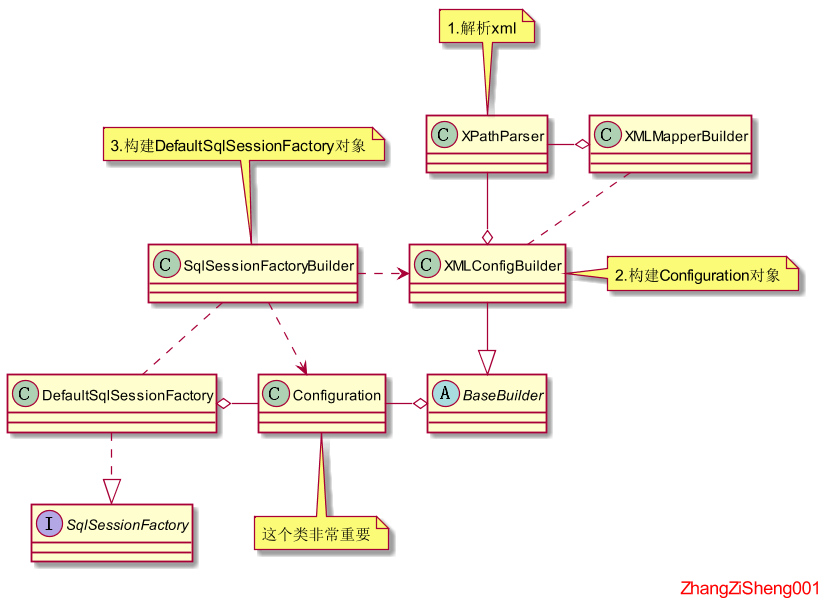
- 构建 xml 的“节点树”。
XPathParser使用的是 JDK 自带的 JAXP API来解析并构建Document对象,并且支持 XPath 功能。 - 初始化
Configuration对象的成员属性。XMLConfigBuilder利用“节点树”来构建Configuration对象(也会去解析注解的配置),Configuration对象包含了 configuration 文件和 mapper 文件的所有配置信息。这部分内容比较难,尤其是初始化 mapper 相关的配置。 - 创建
SqlSessionFactory。SqlSessionFactoryBuilder利用构建好的Configuration对象来创建SqlSessionFactory。
上面的过程只要进入到SqlSessionFactoryBuilder.build(InputStream)方法就可以直观的看到。
public SqlSessionFactory build(InputStream inputStream) {
return build(inputStream, null, null);
}
// 入参里我们可以指定使用哪个环境,还可以传入properties来“覆盖”xml中<properties>变量
public SqlSessionFactory build(InputStream inputStream, String environment, Properties properties) {
try {
// 1. 构建XMLConfigBuilder对象,这个过程会构建Document对象
XMLConfigBuilder parser = new XMLConfigBuilder(inputStream, environment, properties);
// 2. 构建Configuration对象后,然后调用build(Configuration)
return build(parser.parse());
} catch(Exception e) {
throw ExceptionFactory.wrapException("Error building SqlSession.", e);
} finally {
ErrorContext.instance().reset();
try {
inputStream.close();
} catch(IOException e) {
// Intentionally ignore. Prefer previous error.
}
}
}
public SqlSessionFactory build(Configuration config) {
// 3. 直接使用构造方法构建DefaultSqlSessionFactory对象
return new DefaultSqlSessionFactory(config);
}
接下来会具体分析第1和2点的代码,第3点比较简单,就不展开了。
构建xml节点树
XMLConfigBuilder使用XPathParser来解析 xml 获得“节点树”,它本身会通过“节点树”的配置信息来进行初始化操作。现在我们进入到XMLConfigBuilder的构造方法:
private final XPathParser parser;
private String environment;
public XMLConfigBuilder(InputStream inputStream, String environment, Properties props) {
// 构建XPathParser对象,构建时去解析xml
this(new XPathParser(inputStream, true, props, new XMLMapperEntityResolver()), environment, props);
}
// 这里只是初始化XMLConfigBuilder的几个成员属性
private XMLConfigBuilder(XPathParser parser, String environment, Properties props) {
// ······
}
XPathParser的构造方法里将对 xml 进行解析,如下。点进 XPathParser.createDocument(InputSource)方法就会发现 mybatis 使用的是 JAXP 的 API,这部分的内容就不在本文的讨论范围,感兴趣可参考我的另一篇博客: 源码详解系列(三) ------ dom4j的使用和分析(重点对比和DOM、SAX的区别) 。
private final Document document;
private Properties variables;
public XPathParser(Reader reader, boolean validation, Properties variables, EntityResolver entityResolver) {
// 初始化一列成员属性,没必要看
commonConstructor(validation, variables, entityResolver);
// 构建Document对象,使用的是JAXP的API
this.document = createDocument(new InputSource(reader));
}
这里补充说明下XMLMapperEntityResolver这个类。它是EntityResolver子类,xml 的解析会基于事件触发对应的 Resolver 或 Handler,当解析到 dtd 等外部资源时会触发EntityResolver的resolveEntity方法。在XMLMapperEntityResolver.resolveEntity中,当解析到 mybatis-3-config.dtd、mybatis-3-mapper.dtd 等资源时,会直接从 classpath 下的 org/apache/ibatis/builder/xml/ 路径获取资源,而不需要通过 url 获取。
注意,上面对构建的Document对象,只是 configuration 文件的,并不包含 mapper 文件。
先认识下Configuration这个类
我们已经拿到了配置信息,接下来就是构建Configuration对象了。
在此之前,我们先认识下Configurantion这个类,如下图。可以看到,这些成员属性对应了 xml 文件中各个配置项,接下来讲的就是如何初始化这些属性。
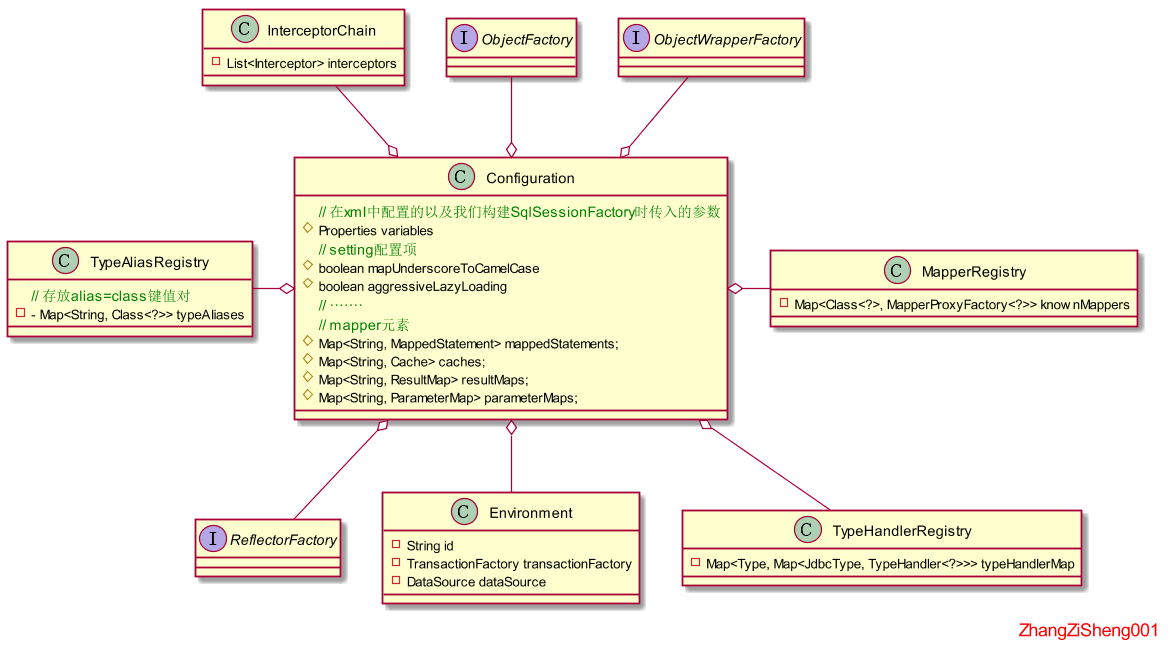
进入到XMLConfigBuilder.parse()方法,可以看到所有配置项的初始化顺序。这里的XNode类是 mybatis 对org.w3c.dom.Node的包装,为后续操作 xml 节点提供了更加简便的接口。
public Configuration parse() {
if (parsed) {
throw new BuilderException("Each XMLConfigBuilder can only be used once.");
}
// 标记已经解析过
parsed = true;
// 通过Document对象构建configuration节点的XNode对象,并构建Configurantion对象
parseConfiguration(parser.evalNode("/configuration"));
return configuration;
}
private void parseConfiguration(XNode root) {
try {
// 以下初始化不同的配置项
propertiesElement(root.evalNode("properties"));
Properties settings = settingsAsProperties(root.evalNode("settings"));
loadCustomVfs(settings);
loadCustomLogImpl(settings);
typeAliasesElement(root.evalNode("typeAliases"));
pluginElement(root.evalNode("plugins"));
objectFactoryElement(root.evalNode("objectFactory"));
objectWrapperFactoryElement(root.evalNode("objectWrapperFactory"));
reflectorFactoryElement(root.evalNode("reflectorFactory"));
settingsElement(settings);
// read it after objectFactory and objectWrapperFactory issue #631
environmentsElement(root.evalNode("environments"));
databaseIdProviderElement(root.evalNode("databaseIdProvider"));
typeHandlerElement(root.evalNode("typeHandlers"));
mapperElement(root.evalNode("mappers"));
} catch (Exception e) {
throw new BuilderException("Error parsing SQL Mapper Configuration. Cause: " + e, e);
}
}
接下来会挑其中几个配置项展开分析,而不会每个都讲到,重点关注 typeHandlers 和 mapper 节点的配置。
properties
properties 是 xml 中使用的全局参数,可以在 xml 中显式配置或引入外部 properties 文件,也可以在构建SqlSessionFactory对象时通过方法入参传入(比较少用),通过下面的代码可以知道:
- properties节点的属性 resource 和 url 只能配置一个,两个都配置会报错;
- 不同方式配置会覆盖,优先级如下:方法入参方式 > xml 中引入外部 properties 文件方式 > xml 中显示配置方式,优先级低的会被优先级高的覆盖。
private void propertiesElement(XNode context) throws Exception {
if (context != null) {
// 获取xml里显式配置的所有property
Properties defaults = context.getChildrenAsProperties();
// 获取resource和url属性值
String resource = context.getStringAttribute("resource");
String url = context.getStringAttribute("url");
// resource和url只能有一个
if (resource != null && url != null) {
throw new BuilderException("The properties element cannot specify both a URL and a resource based property file reference. Please specify one or the other.");
}
// 添加resource或url指定资源的properties,如果相同,就覆盖
if (resource != null) {
defaults.putAll(Resources.getResourceAsProperties(resource));
} else if (url != null) {
defaults.putAll(Resources.getUrlAsProperties(url));
}
// 添加方法入参的properties,如果相同,就覆盖
Properties vars = configuration.getVariables();
if (vars != null) {
defaults.putAll(vars);
}
// 重新设置XPathParser对象和Configuration对象里的成员属性,以备后面配置项使用
parser.setVariables(defaults);
configuration.setVariables(defaults);
}
}
settings
setting 的初始化过程比较简单,这里我们重点关注下MetaClass这个类。
private final ReflectorFactory localReflectorFactory = new DefaultReflectorFactory();
private Properties settingsAsProperties(XNode context) {
if (context == null) {
return new Properties();
}
// 获取settings子节点的配置信息
Properties props = context.getChildrenAsProperties();
// 判断该配置项是否存在,不合法会抛错
MetaClass metaConfig = MetaClass.forClass(Configuration.class, localReflectorFactory);
for (Object key : props.keySet()) {
if (!metaConfig.hasSetter(String.valueOf(key))) {
throw new BuilderException("The setting " + key + " is not known. Make sure you spelled it correctly (case sensitive).");
}
}
return props;
}
// 这里就是直接初始化属性了
private void settingsElement(Properties props) {
// ······
}
通常情况下,如果要判断一个配置参数是否存在,可能会在代码中将参数集给写死,但是 mybatis 没有这么做,它提供了一个非常好用的工具类--MetaClass。MetaClass可以用来初始化某个类的参数集,例如Configuration,并且提供了这些参数的Invoker对象,通过它可以进行值的设置和获取。这个类将在后续源码分析中多次出现。
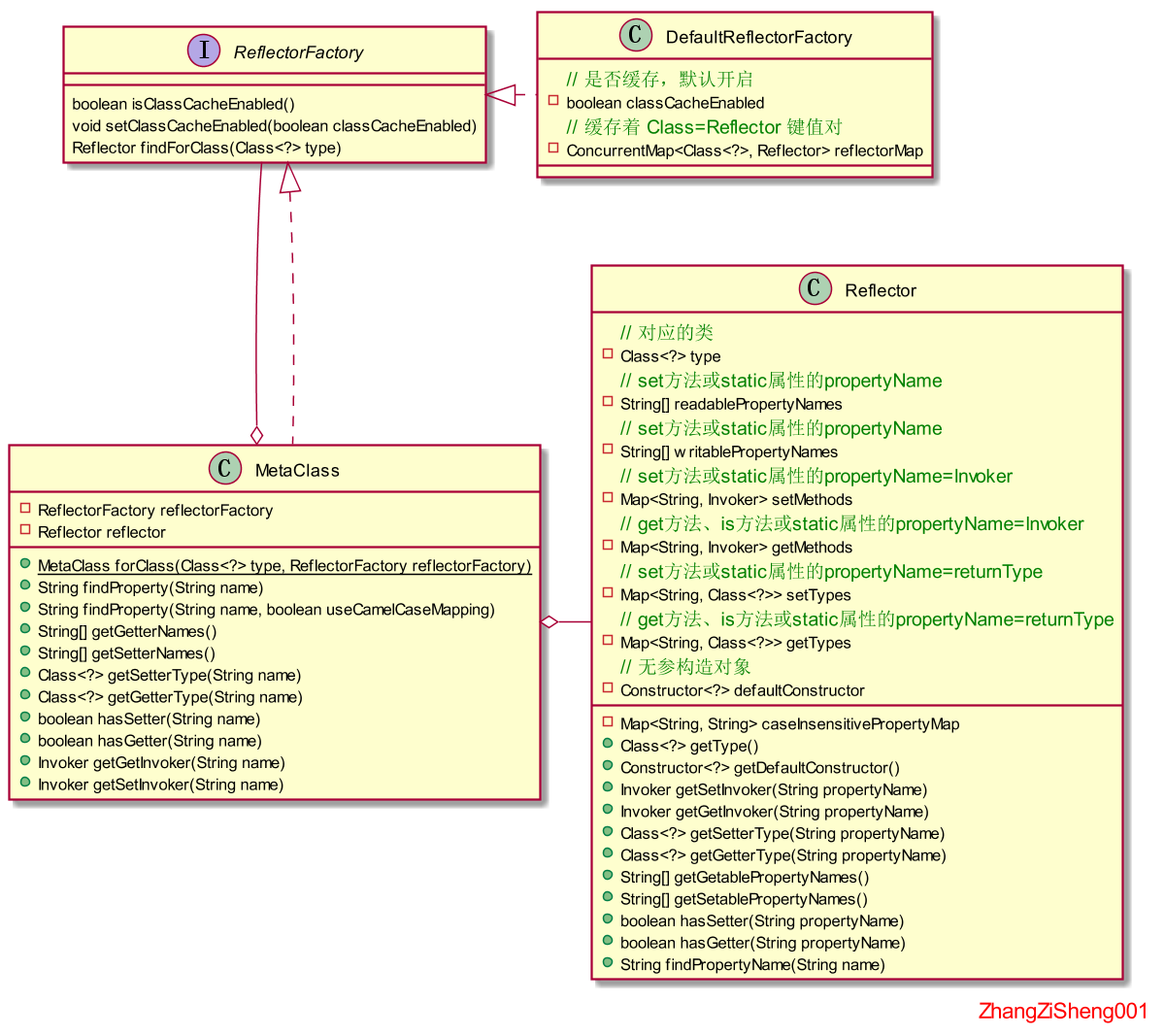
typeAliases
TypeAliasRegistry,即别名注册器,存放着 alias = Class 的键值对,这些别名仅限于在加载配置的时候使用。
我们可以通过两种方式配置:package 和 typeAlias 的方式,而且这两种方式可以共存。
private void typeAliasesElement(XNode parent) {
if (parent != null) {
// 遍历typeAliases下的typeAlias或package节点
for (XNode child : parent.getChildren()) {
// 配置包的情况
if ("package".equals(child.getName())) {
String typeAliasPackage = child.getStringAttribute("name");
// 使用包名注册
configuration.getTypeAliasRegistry().registerAliases(typeAliasPackage);
} else {
// 配置具体类的情况
String alias = child.getStringAttribute("alias");
String type = child.getStringAttribute("type");
try {
// 加载指定类
Class<?> clazz = Resources.classForName(type);
if (alias == null) {
// 如果没有通过xml显式设置别名,将读取该类的Alias注解里的value值
// 如果没有通过xml或注解显式设置别名,将使用该Class对象的simpleName小写作为别名
typeAliasRegistry.registerAlias(clazz);
} else {
typeAliasRegistry.registerAlias(alias, clazz);
}
} catch (ClassNotFoundException e) {
throw new BuilderException("Error registering typeAlias for '" + alias + "'. Cause: " + e, e);
}
}
}
}
}
这里只看使用 package 注册别名的情况,进入到TypeAliasRegistry.registerAliases(String)方法。通过以下代码可知,注册别名时无法注册接口或内部类。这里 mybatis 又提供了一个好用的工具类--ResolverUtil,通过ResolverUtil我们可以获取到指定包路径下的接口、注解或指定类的子类。
public void registerAliases(String packageName) {
// 查找指定包名下Object的子类,并注册别名
registerAliases(packageName, Object.class);
}
public void registerAliases(String packageName, Class<?> superType) {
ResolverUtil<Class<?>> resolverUtil = new ResolverUtil<>();
// 查找指定包名下superType的子类
resolverUtil.find(new ResolverUtil.IsA(superType), packageName);
Set<Class<? extends Class<?>>> typeSet = resolverUtil.getClasses();
for (Class<?> type : typeSet) {
// 跳过内部类和接口
if (!type.isAnonymousClass() && !type.isInterface() && !type.isMemberClass()) {
// 注册指定类的别名
registerAlias(type);
}
}
}
接着进入TypeAliasRegistry.registerAlias(Class<?>)。因为按 package 注册别名的方式没有在 xml 中指定别名,所以,这里会试图从类的Alias注解里获取,如果没有,默认使用该类的 simpleName。
public void registerAlias(Class<?> type) {
// 获取指定类的simpleName
String alias = type.getSimpleName();
// 获取指定类的Alias注解
Alias aliasAnnotation = type.getAnnotation(Alias.class);
if (aliasAnnotation != null) {
// 如果不为空,设置别名为注解里的value
alias = aliasAnnotation.value();
}
// 注册指定类的别名
registerAlias(alias, type);
}
最后进入TypeAliasRegistry.registerAlias(String, Class<?>)方法,通过以下代码可知,别名都会被转化为小写,而且,如果同一个别名注册多个不同的类,会报错。最终会以 alias=Class 的键值对存入TypeAliasRegistry维护的 map中,供其他配置项使用。
// 存放着 alias=Class 的键值对
private final Map<String, Class<?>> typeAliases = new HashMap<>();
public void registerAlias(String alias, Class<?> value) {
if (alias == null) {
throw new TypeException("The parameter alias cannot be null");
}
// 取别名的小写
String key = alias.toLowerCase(Locale.ENGLISH);
// 如果相同的别名或类已经注册过,会抛错
if (typeAliases.containsKey(key) && typeAliases.get(key) != null && !typeAliases.get(key).equals(value)) {
throw new TypeException("The alias '" + alias + "' is already mapped to the value '" + typeAliases.get(key).getName() + "'.");
}
// 存入键值对
typeAliases.put(key, value);
}
plugins
插件/拦截器的初始化比较简单,就简单过一下吧。通过代码可知,我们可以在 plugin 节点下增加 property节点。
private void pluginElement(XNode parent) throws Exception {
if (parent != null) {
for (XNode child : parent.getChildren()) {
// 获取interceptor名
String interceptor = child.getStringAttribute("interceptor");
// 获取interceptor的参数
Properties properties = child.getChildrenAsProperties();
// 实例化。注意,这里解析Class时会先从别名注册器查,没有才会用Class.forName的方式实例化
Interceptor interceptorInstance = (Interceptor) resolveClass(interceptor).getDeclaredConstructor().newInstance();
// 设置参数
interceptorInstance.setProperties(properties);
// 添加到configuration的interceptorChain
configuration.addInterceptor(interceptorInstance);
}
}
}
environments
这里的Environment对象包含了两个部分:事务工厂和数据源,并且使用 id 作为唯一标识。在下面的代码中,事务工厂和数据源的实例化过程有点类似于插件的过程,这里就不展开了。
private void environmentsElement(XNode context) throws Exception {
if (context != null) {
// 如果没有指定环境,会使用default
if (environment == null) {
environment = context.getStringAttribute("default");
}
for (XNode child : context.getChildren()) {
String id = child.getStringAttribute("id");
// 判断是否指定环境
if (isSpecifiedEnvironment(id)) {
// 根据配置的transactionManager创建TransactionFactory对象
TransactionFactory txFactory = transactionManagerElement(child.evalNode("transactionManager"));
// 根据配置的dataSource创建DataSourceFactory对象
DataSourceFactory dsFactory = dataSourceElement(child.evalNode("dataSource"));
// 获取数据源
DataSource dataSource = dsFactory.getDataSource();
// 根据id(环境名)、数据源和事务工厂构建并设置Environment对象
Environment.Builder environmentBuilder = new Environment.Builder(id)
.transactionFactory(txFactory)
.dataSource(dataSource);
configuration.setEnvironment(environmentBuilder.build());
}
}
}
}
typeHandlers*
配置TypeHandler的规则
TypeHandler用于处理参数映射和结果集映射,一个TypeHandler一般需要包含 javaType 和 jdbcType 两个属性来标识,如果某个 javaType 和数据库的 jdbcType 关系为的 一对一或一对多,则可以不用设置 jdbcType。例如BooleanTypeHandler、ByteTypeHandler。
在分析源码前,我们先来看看声明 javaType 和 jdbcType 的几种方式:
- xml 中声明,如下
<typeHandlers>
<typeHandler handler="org.mybatis.example.ExampleTypeHandler" javaType="String" jdbcType="VARCHAR"/>
</typeHandlers>
- 在注解中声明,如下:
@MappedTypes(value = String.class)
@MappedJdbcTypes(value = JdbcType.VARCHAR)
public class ExampleTypeHandler implements TypeHandler<String> {
}
- 在泛型中声明,如下。这种只能用来配置 javaType,而且,必须继承
BaseTypeHandler或TypeReference才行。
public class BigDecimalTypeHandler extends BaseTypeHandler<BigDecimal> {
}
兼容的配置方式越多,代码逻辑也会更复杂,如果 xml 中没有显式地配置 javaType 或 jdbcType,mybatis 会尝试去推断出来,只要明白这个逻辑,接下来的代码就简单很多了。
源码分析
现在开始分析源码吧。我们可以使用 package 和 typeHandler 的两种配置方式,且它们可以共存。
private void typeHandlerElement(XNode parent) {
if (parent != null) {
for (XNode child : parent.getChildren()) {
// 使用包名注册的情况
if ("package".equals(child.getName())) {
String typeHandlerPackage = child.getStringAttribute("name");
typeHandlerRegistry.register(typeHandlerPackage);
} else {
//使用具体类名注册的情况
String javaTypeName = child.getStringAttribute("javaType");
String jdbcTypeName = child.getStringAttribute("jdbcType");
String handlerTypeName = child.getStringAttribute("handler");
Class<?> javaTypeClass = resolveClass(javaTypeName);
JdbcType jdbcType = resolveJdbcType(jdbcTypeName);
Class<?> typeHandlerClass = resolveClass(handlerTypeName);
if (javaTypeClass != null) {
if (jdbcType == null) {
// javaType不为空,jdbcType为空的情况
typeHandlerRegistry.register(javaTypeClass, typeHandlerClass);
} else {
// javaType不为空,jdbcType不为空的情况
typeHandlerRegistry.register(javaTypeClass, jdbcType, typeHandlerClass);
}
} else {
// javaType为空,jdbcType为空的情况
typeHandlerRegistry.register(typeHandlerClass);
}
}
}
}
}
按 package 注册类型处理器的方式有点像前面提到的按 package 注册别名,都会先加载指定包里的类,这里就不展开了,直接看按类名注册的情况(不指定 javaType 和 jdbcType),进入到TypeHandlerRegistry.register(Class<?>)方法。这种情况下,mybatis 会先去推断出该类型处理器对应的 javaType,方法如下:
- 通过 MappedTypes 注解的 value 来判断;
- 通过泛型判断,这种类型处理器需要继承BaseTypeHandler,而不仅仅只是实现TypeHandler。(3.1.0之后才支持)
public void register(Class<?> typeHandlerClass) {
boolean mappedTypeFound = false;
// 获取指定类型处理器的MappedTypes注解,里面的value就是该类型处理器处理的javaType
MappedTypes mappedTypes = typeHandlerClass.getAnnotation(MappedTypes.class);
if (mappedTypes != null) {
// 获取MappedTypes注解的value,并遍历
for (Class<?> javaTypeClass : mappedTypes.value()) {
// 根据javaType注册类型处理器
register(javaTypeClass, typeHandlerClass);
mappedTypeFound = true;
}
}
// 如果没有MappedTypes注解,mybatis 3.1.0之后会通过泛型推断出javaType,但这种类型处理器需要继承BaseTypeHandler,而不仅仅只是实现TypeHandler
if (!mappedTypeFound) {
register(getInstance(null, typeHandlerClass));
}
}
接下来就是推断 jdbcType 了,这里会通过 MappedJdbcTypes 注解来确定(可配置多个 jdbcType),如果设置了includeNullJdbcType=true,则会将 jdbcTyp 为 null 情况也注册上去。如果没有MappedJdbcTypes 注解,会直接将 jdbcTyp 为 null 情况也注册上去。
public void register(Class<?> javaTypeClass, Class<?> typeHandlerClass) {
// 实例化类型处理器,并根据javaType注册
register(javaTypeClass, getInstance(javaTypeClass, typeHandlerClass));
}
public <T> void register(Class<T> javaType, TypeHandler<? extends T> typeHandler) {
// 强转javaType为Type类型
register((Type) javaType, typeHandler);
}
private <T> void register(Type javaType, TypeHandler<? extends T> typeHandler) {
// 获取类型处理器的MappedJdbcTypes注解,里面的value就是该类型处理器处理的jdbcType
MappedJdbcTypes mappedJdbcTypes = typeHandler.getClass().getAnnotation(MappedJdbcTypes.class);
if (mappedJdbcTypes != null) {
// 获取MappedJdbcTypes注解的value,并遍历
for (JdbcType handledJdbcType : mappedJdbcTypes.value()) {
// 根据javaType和jdbcType注册类型处理器
register(javaType, handledJdbcType, typeHandler);
}
// 读取MappedJdbcTypes注解的includeNullJdbcType,如果为true,则根据javaType注册类型处理器
// 当includeNullJdbcType为true时,即使不指定jdbcType,该类型处理器也能被使用。从 Mybatis 3.4.0 开始,如果某个 Java 类型只有一个注册的类型处理器,即使没有设置 includeNullJdbcType=true,那么这个类型处理器也会是 ResultMap 使用 Java 类型时的默认处理器。
if (mappedJdbcTypes.includeNullJdbcType()) {
register(javaType, null, typeHandler);
}
} else {
// 根据javaType注册类型处理
register(javaType, null, typeHandler);
}
}
最后就是具体的注册过程了。mybatis 进行参数或结果集映射时一般用到的是 typeHandlerMap,其他的成员属性一般用于判断是否有某种类型处理器。
// javaType=(jdbcType=typeHandler)
private final Map<Type, Map<JdbcType, TypeHandler<?>>> typeHandlerMap = new ConcurrentHashMap<>();
// class=typeHandler,这个没什么用
private final Map<Class<?>, TypeHandler<?>> allTypeHandlersMap = new HashMap<>();
private void register(Type javaType, JdbcType jdbcType, TypeHandler<?> handler) {
// 只有javaType非空时才会放入typeHandlerMap
if (javaType != null) {
// 从typeHandlerMap里获取当前javaType的jdbcType=TypeHandler
Map<JdbcType, TypeHandler<?>> map = typeHandlerMap.get(javaType);
// 如果这张表为空,则重置
if (map == null || map == NULL_TYPE_HANDLER_MAP) {
map = new HashMap<>();
}
// 放入当前需要注册的jdbcType=TypeHandler,注意,相同的会被覆盖掉
map.put(jdbcType, handler);
// 放入javaType=map
typeHandlerMap.put(javaType, map);
}
// allTypeHandlersMap放入了所有的handler,包括javaType为空的。
allTypeHandlersMap.put(handler.getClass(), handler);
}
mappers*
mapper 的节点对象
接下来就是初始化中最难的部分了。因为 mybatis 的 mapper 支持了非常多个语法,甚至还允许使用注解配置,所以,在对 mapper 的解析方面需要非常复杂的逻辑。我们先来看看 mapper 中的配置项,如下。
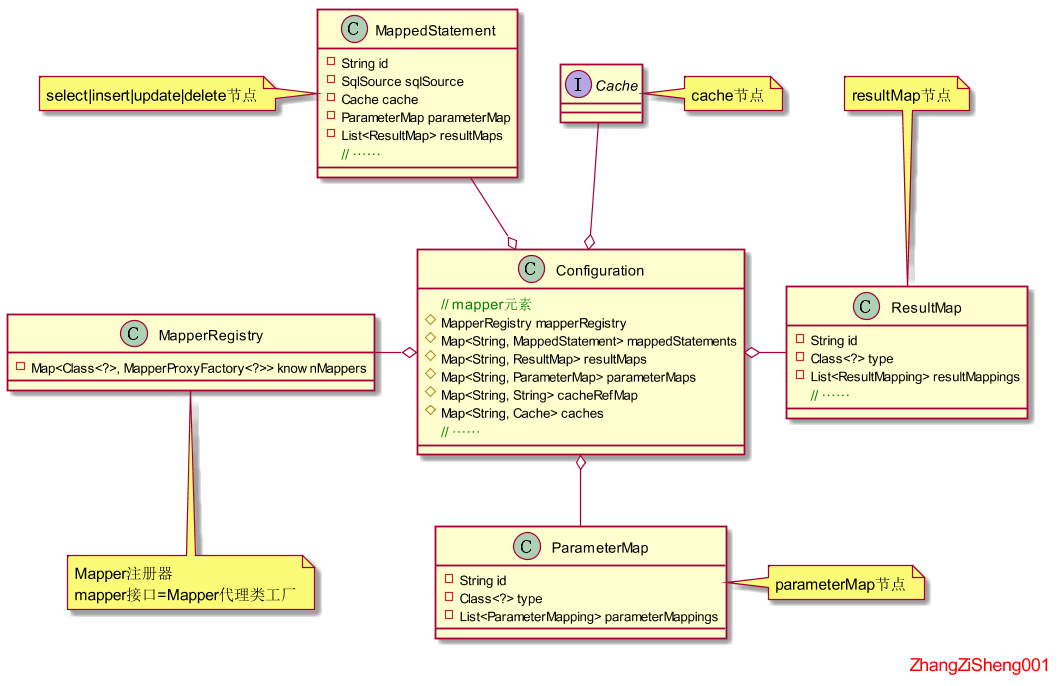
ResultMap的组成
接下来我只会写 resultMap 节点的 xml 配置,其他的就不写了。为了更好地理清代码逻辑,我们先看看 resultMap 的几种配置方式。
<resultMap id="detailedBlogResultMap" type="Blog">
<constructor>
<idArg column="blog_id" javaType="int" />
</constructor>
<result property="title" column="blog_title" />
<association property="author" javaType="Author">
<id property="id" column="author_id" />
<result property="username" column="author_username" />
<result property="password" column="author_password" />
<result property="email" column="author_email" />
</association>
<collection property="posts" ofType="Post">
<id property="id" column="post_id" />
<result property="subject" column="post_subject" />
<association property="author" javaType="Author" />
<collection property="comments" ofType="Comment">
<id property="id" column="comment_id" />
</collection>
<collection property="tags" ofType="Tag">
<id property="id" column="tag_id" />
</collection>
</collection>
<discriminator javaType="int" column="draft">
<case value="1" resultMap="resultMap01"/>
<case value="2" resultMap="resultMap02"/>
<case value="3" resultMap="resultMap03"/>
<case value="4" resultMap="resultMap04"/>
</discriminator>
</resultMap>
针对上面的配置,需要重点理解:
- 整个 resultMap 将作为
ResultMap对象存在,并使用 id 作为唯一标识。除了 id="detailedBlogResultMap" 的ResultMap对象,association 、collection 和 case 节点也会生成新的ResultMap对象(如果不是配置 resultMap 和 select 属性的话)。 - idArg、result、association 和 collection 节点都会被转换为
ResultMapping对象被ResultMap对象持有,区别在于 association 和 collection 的ResultMapping对象会持有 nestedResultMapId 来指向另外一个ResultMap对象,持有 nestedQueryId 来指向另外一个MappedStatement对象。 - discriminator 节点,将转换为
Discriminator对象被ResultMap对象持有。
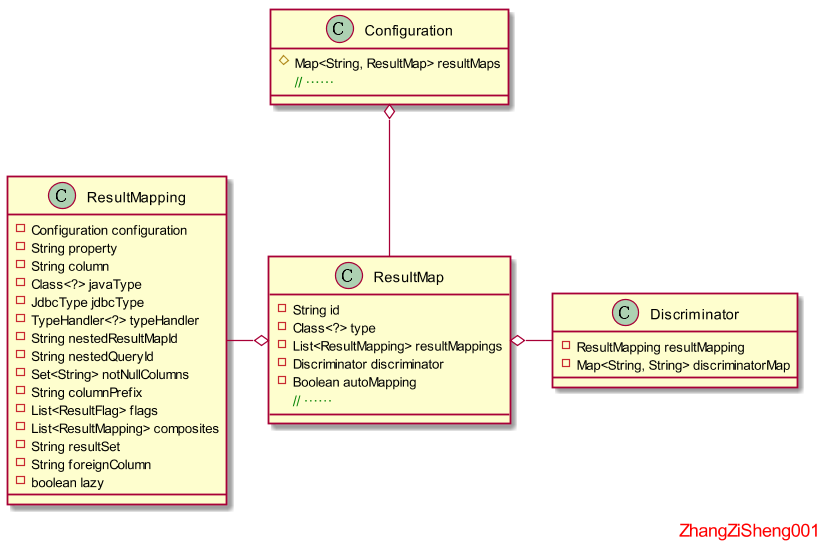
源码分析
那么,开始看源码吧。mapper 的配置支持下面两种配置,两者可以共存:
- mapper 节点配置。支持 resource、url 和 class 属性,但这三个属性只能配置一个,不然会报错。
- package 节点配置。
private void mapperElement(XNode parent) throws Exception {
if (parent != null) {
for (XNode child : parent.getChildren()) {
// 使用包配置的情况
if ("package".equals(child.getName())) {
String mapperPackage = child.getStringAttribute("name");
configuration.addMappers(mapperPackage);
} else {
// 使用mapper配置的情况
String resource = child.getStringAttribute("resource");
String url = child.getStringAttribute("url");
String mapperClass = child.getStringAttribute("class");
if (resource != null && url == null && mapperClass == null) {
// resource属性不为空
ErrorContext.instance().resource(resource);
InputStream inputStream = Resources.getResourceAsStream(resource);
XMLMapperBuilder mapperParser = new XMLMapperBuilder(inputStream, configuration, resource, configuration.getSqlFragments());
mapperParser.parse();
} else if (resource == null && url != null && mapperClass == null) {
// url属性不为空
ErrorContext.instance().resource(url);
InputStream inputStream = Resources.getUrlAsStream(url);
XMLMapperBuilder mapperParser = new XMLMapperBuilder(inputStream, configuration, url, configuration.getSqlFragments());
mapperParser.parse();
} else if (resource == null && url == null && mapperClass != null) {
// class属性不为空
Class<?> mapperInterface = Resources.classForName(mapperClass);
configuration.addMapper(mapperInterface);
// resource、url和class只能存在一个
} else {
throw new BuilderException("A mapper element may only specify a url, resource or class, but not more than one.");
}
}
}
}
}
使用 package 配置 mapper 的情况,会有加载包内类的过程,和前面的 typeAliases 差不多,所以这里选择使用 mapper 配置(属性为class)的情况,进入到Configuration.addMapper(Class<T>)。在注册 mapper 时,其实有两个内容:
- 注册 mapper 接口,初始化 mapperRegistry 里的 type=mapperProxyFactory 的map。
MapperProxyFactory用于生成Mapper的代理类,后面会讲到。 - 解析 mapper 的 xml 文件和注解,初始化 mappedStatements、caches、resultMaps、parameterMaps 等属性。
public <T> void addMapper(Class<T> type) {
mapperRegistry.addMapper(type);
}
public <T> void addMapper(Class<T> type) {
// 只有是接口才行
if (type.isInterface()) {
// 该mapper是不是已经注册
if (hasMapper(type)) {
throw new BindingException("Type " + type + " is already known to the MapperRegistry.");
}
boolean loadCompleted = false;
try {
// 注册该mapper接口
knownMappers.put(type, new MapperProxyFactory<>(type));
// 接下来解析mapper的xml和注解,不要被MapperAnnotationBuilder这个类名误导,接下来不止会解析注解,也会解析xml
MapperAnnotationBuilder parser = new MapperAnnotationBuilder(config, type);
parser.parse();
loadCompleted = true;
} finally {
if (!loadCompleted) {
knownMappers.remove(type);
}
}
}
}
进入到MapperAnnotationBuilder.parse()方法,这里先解析 xml 文件,再解析注解。接下来我们只看 xml 的,注解的就不看了。
// 存放已加载的资源
protected final Set<String> loadedResources = new HashSet<>();
public void parse() {
String resource = type.toString();
// 该资源未被加载才进入
if (!configuration.isResourceLoaded(resource)) {
// 加载xml
loadXmlResource();
// 标记已加载
configuration.addLoadedResource(resource);
assistant.setCurrentNamespace(type.getName());
// 接下来是解析注解
parseCache();
parseCacheRef();
Method[] methods = type.getMethods();
for (Method method : methods) {
try {
// issue #237
if (!method.isBridge()) {
parseStatement(method);
}
} catch (IncompleteElementException e) {
// 未解析完成,会放入对应的集合中,等待最后再解析
configuration.addIncompleteMethod(new MethodResolver(this, method));
}
}
}
// 因为存在嵌套引用的问题,有些内容还没解析完,这里会做最后的解析
parsePendingMethods();
}
进入到MapperAnnotationBuilder.loadXmlResource()方法。这里的XMLMapperBuilder用于解析 mapper 文件的配置,前面说到的XMLConfigBuilder则是解析 configurantion 文件的配置,它们都是BaseBuilder的子类。
private void loadXmlResource() {
// 该命名空间未被加载,才会进入
if (!configuration.isResourceLoaded("namespace:" + type.getName())) {
// 根据mapper获取xml
String xmlResource = type.getName().replace('.', '/') + ".xml";
InputStream inputStream = type.getResourceAsStream("/" + xmlResource);
if (inputStream == null) {
// Search XML mapper that is not in the module but in the classpath.
try {
inputStream = Resources.getResourceAsStream(type.getClassLoader(), xmlResource);
} catch (IOException e2) {
// ignore, resource is not required
}
}
if (inputStream != null) {
// 和XMLConfigBuilder一样,这里会解析xml并构建document
XMLMapperBuilder xmlParser = new XMLMapperBuilder(inputStream, assistant.getConfiguration(), xmlResource, configuration.getSqlFragments(), type.getName());
// 进入解析
xmlParser.parse();
}
}
}
进入到XMLMapperBuilder.parse()。我们会发现,如果使用 resource 或 url 的方式来配置 mapper,那么 Mapper 接口的注册会在这个方法里。
public void parse() {
// 该资源未加载才会进入
if (!configuration.isResourceLoaded(resource)) {
// 构建mapper节点的XNode对象,并解析
configurationElement(parser.evalNode("/mapper"));
// 标记已解析
configuration.addLoadedResource(resource);
// 注册Mapper接口,其实这个注册过了的
bindMapperForNamespace();
}
// 因为存在嵌套引用的问题,有的节点还没初始化完成,这里继续初始化
parsePendingResultMaps();
parsePendingCacheRefs();
parsePendingStatements();
}
private void configurationElement(XNode context) {
try {
// mapper文件的namespace不能为空
String namespace = context.getStringAttribute("namespace");
if (namespace == null || namespace.equals("")) {
throw new BuilderException("Mapper's namespace cannot be empty");
}
builderAssistant.setCurrentNamespace(namespace);
// 接下来讲初始化各个节点
cacheRefElement(context.evalNode("cache-ref"));
cacheElement(context.evalNode("cache"));
parameterMapElement(context.evalNodes("/mapper/parameterMap"));
resultMapElements(context.evalNodes("/mapper/resultMap"));
sqlElement(context.evalNodes("/mapper/sql"));
buildStatementFromContext(context.evalNodes("select|insert|update|delete"));
} catch (Exception e) {
throw new BuilderException("Error parsing Mapper XML. The XML location is '" + resource + "'. Cause: " + e, e);
}
}
前面已经说过,我们只看 resultMap 的构建,进入到XMLMapperBuilder.resultMapElements(List<XNode>)。
private void resultMapElements(List<XNode> list) {
// 我们可以配置多个resultMap,这里一个个遍历
for (XNode resultMapNode : list) {
try {
// 解析resultMap节点
resultMapElement(resultMapNode);
} catch (IncompleteElementException e) {
// ignore, it will be retried
}
}
}
private ResultMap resultMapElement(XNode resultMapNode) {
return resultMapElement(resultMapNode, Collections.emptyList(), null);
}
// 注意,这个类传入的resultMapNode不仅是resultMap节点,也可以是association、collection或case节点
// 如果是association、collection或case节点,enclosingType为当前resultMap节点的type,additionalResultMappings为所属resultMap的ResultMappings
private ResultMap resultMapElement(XNode resultMapNode, List<ResultMapping> additionalResultMappings, Class<?> enclosingType) {
ErrorContext.instance().activity("processing " + resultMapNode.getValueBasedIdentifier());
// 获取当前的类名
String type = resultMapNode.getStringAttribute("type",
resultMapNode.getStringAttribute("ofType",
resultMapNode.getStringAttribute("resultType",
resultMapNode.getStringAttribute("javaType"))));
// 获取该类的Class对象。如果为空,针对association和case的情况会通过enclosingType来推断
Class<?> typeClass = resolveClass(type);
if (typeClass == null) {
typeClass = inheritEnclosingType(resultMapNode, enclosingType);
}
Discriminator discriminator = null;
List<ResultMapping> resultMappings = new ArrayList<>(additionalResultMappings);
List<XNode> resultChildren = resultMapNode.getChildren();
for (XNode resultChild : resultChildren) {
// 如果为constructor节点
if ("constructor".equals(resultChild.getName())) {
// 这里会将每个idArg或arg转换为ResultMapping对象,并放入resultMappings
processConstructorElement(resultChild, typeClass, resultMappings);
// 如果为discriminator节点
} else if ("discriminator".equals(resultChild.getName())) {
// discriminator将转换为Discriminator对象
discriminator = processDiscriminatorElement(resultChild, typeClass, resultMappings);
// 这种就是的result、collection或association节点了
} else {
List<ResultFlag> flags = new ArrayList<>();
// 标记id
if ("id".equals(resultChild.getName())) {
flags.add(ResultFlag.ID);
}
// 将result、collection或association节点转换为ResultMapping对象,并放入resultMappings,如果是collection或association节点,会指向生成的新的ResultMap对象或已有的ResultMap对象
resultMappings.add(buildResultMappingFromContext(resultChild, typeClass, flags));
}
}
// 获取resultMap的id、extends和autoMapping属性
String id = resultMapNode.getStringAttribute("id",
resultMapNode.getValueBasedIdentifier());
String extend = resultMapNode.getStringAttribute("extends");
Boolean autoMapping = resultMapNode.getBooleanAttribute("autoMapping");
// 创建ResultMapResolver对象
ResultMapResolver resultMapResolver = new ResultMapResolver(builderAssistant, id, typeClass, extend, discriminator, resultMappings, autoMapping);
try {
// 解析resultMap,这里所谓的解析,其实就是将extends的东西放入resultMappings
return resultMapResolver.resolve();
} catch (IncompleteElementException e) {
// 如果没有解析完成,放入集合incompleteResultMaps,等待后面再解析
configuration.addIncompleteResultMap(resultMapResolver);
throw e;
}
}
以上,mybatis 初始化的源码基本已分析完,不足的地方欢迎指正。
相关源码请移步:mybatis-demo
本文为原创文章,转载请附上原文出处链接:https://www.cnblogs.com/ZhangZiSheng001/p/12704076.html

 前面已经说完 mybatis 的使用,现在开始分析源码,和使用例子一样,我用的 mybatis 是 3.5.4 版本的。考虑连贯性,我会按下面的顺序来展开分析,计划两篇博客写完,本文只涉及第一点内容:
1. 加载配置、初始化SqlSessionFactory;
2. 获取SqlSession和Mapper;
3. 执行Mapper方法。
前面已经说完 mybatis 的使用,现在开始分析源码,和使用例子一样,我用的 mybatis 是 3.5.4 版本的。考虑连贯性,我会按下面的顺序来展开分析,计划两篇博客写完,本文只涉及第一点内容:
1. 加载配置、初始化SqlSessionFactory;
2. 获取SqlSession和Mapper;
3. 执行Mapper方法。
